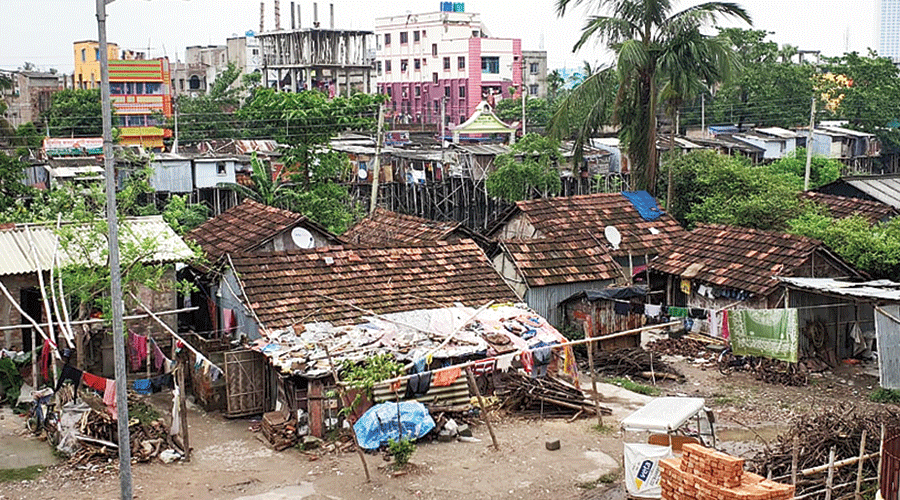New Town residents living along the Bagjola Canal are alarmed at the steady rise in encroachment next to them, especially since the shanty-dwellers are hardly seen wearing masks or maintaining social distancing.
Nanda Mukherjee has been frequenting the canal side since 2010 when his flat in BA Block’s Indian Oil Nabarun Group Housing Co-operative Society was under construction. “Back then, there was not a single hutment on the stretch. But now there are so many one cannot count them. Most are made of tin with tiled roofs but there are many made of bricks too.”

Encroachment along the water Sourced by the Telegraph
The canal stretch in question is behind Central Mall and Dr A.P.J. Abdul Kalam Government College. The same canal flows past the Biswa Bangla Convention Centre but the banks there are clean, beautified and encroachment-free.
Nilotpal Dutta, who lives on Street 116 just a couple of buildings away from the canal, says the slum dwellers dump rubbish into the water, leading to pollution. “As it is, the water is a toxic shade of black. Now there are pockets on the banks that have become hillocks of plastic bags and thermocol plates,” he says. “They have built make-shift toilets above the water too, held up by bamboo stilts and walled by saris.”
A walk around this slum is indeed disorienting. On one side is the planned city of New Town with wide roads, lovely architecture, clean and green. But turn your head and the road is lined with shanties. “What’s scary is that many of these slum-dwellers are auto or toto drivers who wear masks at work but mingle freely without them here every evening,” adds Biswajeet Chowdhury, a resident of BA Block.
Residents cite the master plan of New Town, that promises a canal side road and some greenery next to it, but space for both seems to have been usurped by the squatters. They also complain of mosquitoes that breed in the stagnant canal water. “I’ve lived here for four years now and never have I seen it being dredged,” says Dutta. “Round the year, we have to shut our doors and windows by 3pm if we are to prevent mosquitoes from flying indoors.”
In winter, Chowdhury says mosquitoes are seen flying out of elevators in the higher floors. “They enter our cars before we do, and that too in battalions.”
Mukherjee says the canal is a dustbin for locals, including fish and meat sellers. “We often see dead animals floating in it. And the stench
is so bad that some residents of my housing society have had to move out,” he says.
Early this month, a group of residents from BA Block sent a letter to Housing and Infrastructure Development Corporation (Hidco) and New Town Kolkata Development Authority (NKDA). “Residents here have sent several letters before, including one to the chief minister herself,” says Chowdhury. “We pay taxes just like those who live around Biswa Bangla Gate, then why is it that their area sees so much development but we are neglected?”

Makeshift huts and toilets held above the water by stilts Sourced by the Telegraph
Officialspeak
The canal-side stretch is the jurisdiction of the irrigation department. “Since residents have sent us the letter we shall forward it to the right department,” says Debashis Sen, chairman cum managing director of Hidco and chairman of NKDA. “However, if the canal breeds mosquitoes it is a health concern for those living under NKDA too.”
Sen says that they have conducted a joint survey with Bidhannagar Municipal Corporation where it was found that the waste dumped in canals was the prime reason of them getting choked. They shall now be setting up nets over Bagjola and other canals so that even if people litter, the waste won’t reach the water and will be cleaned up easily.
An official of the irrigation department said they were aware of the problems. “Encroachment is indeed a big problem and we have not been able to deal with it. We have held talks with everyone from MLAs to ministers but have only managed to evict a small portion of the encroached canal side land,” confessed the official.
As for dredging, it was last done here in 2015-16. “De-silting would make it easier for water to flow and allow a much larger quantity of water to flow too but the department’s policy is to dredge it once in five or six years. Talks are on for another round of dredging but nothing has been finalised,” he added.
They have worked hard to remove water hyacinths from the surface of the canal and have labourers working round the year to remove garbage. “But no matter how many times we clean up, the water will not remain clean without the co-operation of locals. Sadly, they have turned the canal into a dumping ground now,” he said.











